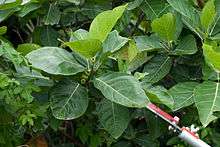Ficus septica
| Ficus septica | |
|---|---|
 | |
| Ficus septica in Taiwan | |
| Scientific classification | |
| Kingdom: | Plantae |
| (unranked): | Angiosperms |
| (unranked): | Eudicots |
| (unranked): | Rosids |
| Order: | Rosales |
| Family: | Moraceae |
| Genus: | Ficus |
| Subgenus: | Sycomorus |
| Species: | F. septica |
| Binomial name | |
| Ficus septica Burm.f. | |
| Synonyms | |
|
List
| |

Ficus septica (called Hauli tree in the Philippines, 棱果榕 in China[1] and Taiwan) is a shrub or tree of the family Moraceae living at low altitudes from Northeast India to North Australia (Queensland), and throughout Malesia.[2] It lives on the edge of the vegetation, often in degraded environments. The seeds of this species are dispersed by numerous species, including fruit bats (Megachiroptera) when present.[3]
Taxonomy
Ficus septica was described first by the Dutch botanist Nicolaas Laurens Burman in 1768. Two centuries later, E. J. H. Corner listed three varieties for Ficus septica: F. septica var. septica distributed all over the range of the species; F. septica var. cauliflora limited to Queensland, Australia and the Solomon islands; and F. septica var. salicifolia endemic to the Philippines Islands.[4] Then in the latest Flora Malesiana edition, Cornelis Christiaan Berg put all these varieties in synonymy together under the name Ficus septica.[2] Within the genus, Ficus septica belongs to the subgenus Sycomorus section Sycocarpus subsection Sycocarpus.
Description
Tree or shrub up to 25 meters.[2] The latex of F. septica is characteristically yellow. Leaves and petioles are both glabrous. Leaves are symmetric, elliptic to oblong. Figs grow often in pairs but can be solitary or in groups of up to four. Figs are depressed-globose to ellipsoid, the apex is flat or concave. Seven to twelve ribs towards to ostiole. At maturity, whitish to yellowish dots appear on the fig. The individuals from Philippines have their stems covered by short hairs while those found in Taiwan are glabrous.
Habitat
Ficus septica trees live up to 1800m in montane forests or secondary growth environments. It can be seen often along rivers. In Taiwan, at the northern limit of its distribution, F. septica lives up to 500m in secondary growths and along roads and coastlines.
Ecology
Ficus septica is pollinated by fig wasps from the genus Ceratosolen. Usually members of the genus Ficus are pollinated by a single species of pollinating fig wasps specific to each fig species, but recent observations of Ficus septica have shown there to be three pollinating species in the South of Taiwan [5] and two in The Philippines.[6]
The figs of Ficus septica have been reported to be eaten by 22 animal species and among them 14 are bats:[3]
- Double-eyed fig parrot
- Unspecified fruit dove
- Black-naped oriole
- Northern common cuscus
- Stein's cuscus
- Common spotted cuscus
- Mantled guereza
- Black rat
- Lesser short-nosed fruit bat
- Horsfield's fruit bat
- Greater short-nosed fruit bat
- Indonesian short-nosed fruit bat
- Bare-backed fruit bat
- Lesser naked-backed fruit bat
- Long-tongued nectar bat
- Long-tongued fruit bat
- Broad-striped tube-nosed fruit bat
- Common tube-nosed fruit bat
- Greater musky fruit bat
- Geoffroy's rousette
- Common blossom bat
References
- ↑ Wu, Z., Raven, P.H. & Hong, D. (2003). "Ulmaceae through Basellaceae". Flora of China. Volume 5: Ulmaceae through Basellaceae 5. ISBN 1-930723-40-7.
- 1 2 3 Berg, C.C. & Corner E.J.H. (2005). "Moraceae". Flora Malesiana. I 17. ISBN 1-930723-40-7.
- 1 2 Shanahan, M.; Compton, S. G.; So, S. & Corlett, R. (2001). "Fig-eating by vertebrate frugivores: a global review" (PDF). Biological Reviews 76 (4): 529–72. doi:10.1017/S1464793101005760. PMID 11762492.
- ↑ Corner, E. J. H. (1965). "Check-list of Ficus in Asia and Australasia with keys to identification". The Gardens' Bulletin Singapore. (digitised, online, via biodiversitylibrary.org) 21 (1): 1–186. Retrieved 5 Feb 2014.
- ↑ Lin, R.-C., Yeung, C.K.-L., Fong, J.J., Tzeng, H.-Y. & Li, S.-H. (2011). "The lack of pollinator specificity in a dioecious fig tree: sympatric fig-pollinating wasps of Ficus septica in southern Taiwan". Biotropica 43: 200–07. doi:10.1111/j.1744-7429.2010.00686.x.
- ↑ L. Conchou, L. Cabioch, L. J. V. Rodriguez, F. Kjellberg (2014). "Daily rhythm of mutualistic pollinator activity and scent emission in Ficus septica: Ecological differentiation between co-occurring pollinators and potential consequences for chemical communication and facilitation of host speciation". PLoS ONE 9: e103581. doi:10.1371/journal.pone.0103581.